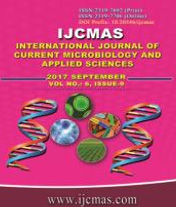


 National Academy of Agricultural Sciences (NAAS)
National Academy of Agricultural Sciences (NAAS)

|
PRINT ISSN : 2319-7692
Online ISSN : 2319-7706 Issues : 12 per year Publisher : Excellent Publishers Email : editorijcmas@gmail.com / submit@ijcmas.com Editor-in-chief: Dr.M.Prakash Index Copernicus ICV 2018: 95.39 NAAS RATING 2020: 5.38 |
Uterine infections in postpartum phase are the most common and of greatest economic importance in dairy animals. Uterine function is often compromised in cattle by bacterial contamination of the uterine lumen after parturition; pathogenic bacteria frequently persist, causing uterine disease, a key cause of infertility. Certain risk factors resulting in an increase in chance of clinical disease are retained placenta, dystocia, twins and stillbirth calves. Although many cows eliminate these bacteria during the first 5 weeks after parturition, but in 10–17% of animals infection persists which causes uterine disease. The presence of pathogenic bacteria in the uterus causes inflammation, histological lesions of the endometrium and delays uterine involution. In addition, uterine bacterial infection, bacterial products or the associated inflammation, suppress pituitary LH secretion, and perturbs postpartum ovarian follicular growth and function, which disrupts ovulation in cattle. Thus, uterine disease is associated with lower conception rates, increased intervals from calving to first service or conception, and more cattle culled for failure to conceive.
 |
 |
 |
 |
 |